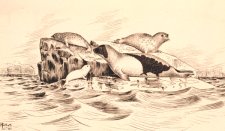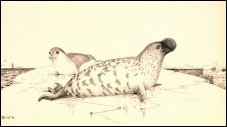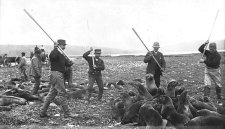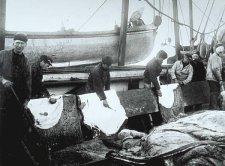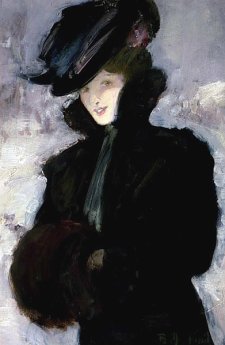| Seals, walruses and bears |
|
Seals Seals had always been taken as a poor alternative on unsuccessful whaling trips but in due course the northern ports, particularly Peterhead, developed a flourishing trade out of sealing. From 1807 to 1814 every whaling expedition to the Greenland sea was profitable. However, during the 1820s the whales were becoming much seriously depleted and the number of loss-making voyages started to increase. In response to this developing crisis the whalers started to move from the relatively safe Greenland Sea to the Davis Strait, to the west of Greenland. This was a hugely dangerous area with ships all too easily becoming trapped in the ice - 19 ships of the 91 strong British fleet were lost in 1830 alone. By 1840 most captains had abandoned the Davis Strait and returned to the Greenland Sea. Because of the scarcity of whales in this area sealing became more and more important. Regular and systematic sealing had started in the 1820, led by Captain David Gray (Senior) of Peterhead. Working from the Active (1) he took 2,500 seals in 1819 and 4,500 in 1820. From then on there was a general shift from whaling to sealing, with the Peterhead fleet leading the way and taking prodigious numbers of seals. The majority of the seals taken were ice-breeding harp seals and hooded seals with smaller numbers of harbour seals, grey seals and walruses. The harvesting of seals was a simple, but brutal operation. Gangs of men landed on the ice floes and clubbed, or shot, the breeding seals, cubs first and then their mothers. Once all the seals on a floe were dead the killing team moved on, leaving a crew to skin the seals and to strip the blubber. Skins and blubber were dragged to the boats. On board ship the skins were cleaned of flesh, salted and stored in the hold. The blubber was 'made off' - cut into strips and packed into barrels under the supervision of the skeeman (officer in charge of the hold). Back in port the seal blubber was boiled to release its oil. The skins were graded and used in various ways. The finest skins from young seals were cured and dyed as furs to be made into muffs, boas and capes. The older, battle scarred skins were tanned for leather. The most sought after were the white furs of pups less than a fortnight old. Given the large numbers of seals that were being killed it was inevitable that populations became under threat. By 1870 conservation measures were being discussed, led by Captain David Gray (Junior) whose grandfather had started the sealing industry. Attempts to organize sealing on a sustainable basis inevitably failed and by the last quarter of the 19th century Peterhead whaling and sealing was in terminal decline. By the time that the industry was truly dead Peterhead had landed 4,200 right whales, 600 bottlenose whales, 1.7 million seals and unknown numbers of walruses, polar bears, narwhals and beluga. |
| |
